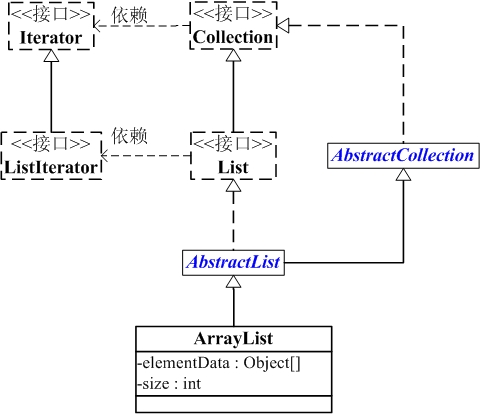摘要:概要上一章,我们学习了Collection的架构。这一章开始,我们对Collection的具体实现类进行讲解;首先,讲解List,而List中ArrayList又最为常用。因此,本章我们讲解ArrayList。先对ArrayList有个整体认识,再学习它的源码,最后再通过例子来学习如何使用它。内容包括:第1部分 ArrayList介绍ArrayList简介ArrayList 是一个数组队列,相当于
概要
上一章,我们学习了Collection的架构。这一章开始,我们对Collection的具体实现类进行讲解;首先,讲解List,而List中ArrayList又最为常用。因此,本章我们讲解ArrayList。先对ArrayList有个整体认识,再学习它的源码,最后再通过例子来学习如何使用它。内容包括:
第1部分 ArrayList介绍
ArrayList简介
ArrayList 是一个数组队列,相当于 动态数组。与Java中的数组相比,它的容量能动态增长。它继承于AbstractList,实现了List, RandomAccess, Cloneable, java.io.Serializable这些接口。
ArrayList 继承了AbstractList,实现了List。它是一个数组队列,提供了相关的添加、删除、修改、遍历等功能。
ArrayList 实现了RandmoAccess接口,即提供了随机访问功能。RandmoAccess是java中用来被List实现,为List提供快速访问功能的。在ArrayList中,我们即可以通过元素的序号快速获取元素对象;这就是快速随机访问。稍后,我们会比较List的“快速随机访问”和“通过Iterator迭代器访问”的效率。
ArrayList 实现了Cloneable接口,即覆盖了函数clone(),能被克隆。
ArrayList 实现java.io.Serializable接口,这意味着ArrayList支持序列化,能通过序列化去传输。
和Vector不同,ArrayList中的操作不是线程安全的!所以,建议在单线程中才使用ArrayList,而在多线程中可以选择Vector或者CopyOnWriteArrayList。
ArrayList构造函数
// 默认构造函数 ArrayList() // capacity是ArrayList的默认容量大小。当由于增加数据导致容量不足时,容量会添加上一次容量大小的一半。 ArrayList(int capacity) // 创建一个包含collection的ArrayList ArrayList(Collection<? extends E> collection)
ArrayList的API
// Collection中定义的API boolean add(E object) boolean addAll(Collection<? extends E> collection) void clear() boolean contains(Object object) boolean containsAll(Collection<?> collection) boolean equals(Object object) int hashCode() boolean isEmpty() Iterator<E> iterator() boolean remove(Object object) boolean removeAll(Collection<?> collection) boolean retainAll(Collection<?> collection) int size() <T> T[] toArray(T[] array) Object[] toArray() // AbstractCollection中定义的API void add(int location, E object) boolean addAll(int location, Collection<? extends E> collection) E get(int location) int indexOf(Object object) int lastIndexOf(Object object) ListIterator<E> listIterator(int location) ListIterator<E> listIterator() E remove(int location) E set(int location, E object) List<E> subList(int start, int end) // ArrayList新增的API Object clone() void ensureCapacity(int minimumCapacity) void trimToSize() void removeRange(int fromIndex, int toIndex)
第2部分 ArrayList数据结构
ArrayList的继承关系
java.lang.Object
↳ java.util.AbstractCollection<E>
↳ java.util.AbstractList<E>
↳ java.util.ArrayList<E>
public class ArrayList<E> extends AbstractList<E>
implements List<E>, RandomAccess, Cloneable, java.io.Serializable {}ArrayList与Collection关系如下图:

ArrayList包含了两个重要的对象:elementData 和 size。
(01) elementData 是"Object[]类型的数组",它保存了添加到ArrayList中的元素。实际上,elementData是个动态数组,我们能通过构造函数 ArrayList(int initialCapacity)来执行它的初始容量为initialCapacity;如果通过不含参数的构造函数ArrayList()来创建ArrayList,则elementData的容量默认是10。elementData数组的大小会根据ArrayList容量的增长而动态的增长,具体的增长方式,请参考源码分析中的ensureCapacity()函数。
(02) size 则是动态数组的实际大小。
第3部分 ArrayList源码解析(基于JDK1.6.0_45)
为了更了解ArrayList的原理,下面对ArrayList源码代码作出分析。ArrayList是通过数组实现的,源码比较容易理解。
package java.util;
public class ArrayList<E> extends AbstractList<E>
implements List<E>, RandomAccess, Cloneable, java.io.Serializable
{
// 序列版本号
private static final long serialVersionUID = 8683452581122892189L;
// 保存ArrayList中数据的数组
private transient Object[] elementData;
// ArrayList中实际数据的数量
private int size;
// ArrayList带容量大小的构造函数。
public ArrayList(int initialCapacity) {
super();
if (initialCapacity < 0)
throw new IllegalArgumentException("Illegal Capacity: "+
initialCapacity);
// 新建一个数组
this.elementData = new Object[initialCapacity];
}
// ArrayList构造函数。默认容量是10。
public ArrayList() {
this(10);
}
// 创建一个包含collection的ArrayList
public ArrayList(Collection<? extends E> c) {
elementData = c.toArray();
size = elementData.length;
// c.toArray might (incorrectly) not return Object[] (see 6260652)
if (elementData.getClass() != Object[].class)
elementData = Arrays.copyOf(elementData, size, Object[].class);
}
// 将当前容量值设为 =实际元素个数
public void trimToSize() {
modCount++;
int oldCapacity = elementData.length;
if (size < oldCapacity) {
elementData = Arrays.copyOf(elementData, size);
}
}
// 确定ArrarList的容量。
// 若ArrayList的容量不足以容纳当前的全部元素,设置 新的容量=“(原始容量x3)/2 + 1”
public void ensureCapacity(int minCapacity) {
// 将“修改统计数”+1
modCount++;
int oldCapacity = elementData.length;
// 若当前容量不足以容纳当前的元素个数,设置 新的容量=“(原始容量x3)/2 + 1”
if (minCapacity > oldCapacity) {
Object oldData[] = elementData;
int newCapacity = (oldCapacity * 3)/2 + 1;
if (newCapacity < minCapacity)
newCapacity = minCapacity;
elementData = Arrays.copyOf(elementData, newCapacity);
}
}
// 添加元素e
public boolean add(E e) {
// 确定ArrayList的容量大小
ensureCapacity(size + 1); // Increments modCount!!
// 添加e到ArrayList中
elementData[size++] = e;
return true;
}
// 返回ArrayList的实际大小
public int size() {
return size;
}
// 返回ArrayList是否包含Object(o)
public boolean contains(Object o) {
return indexOf(o) >= 0;
}
// 返回ArrayList是否为空
public boolean isEmpty() {
return size == 0;
}
// 正向查找,返回元素的索引值
public int indexOf(Object o) {
if (o == null) {
for (int i = 0; i < size; i++)
if (elementData[i]==null)
return i;
} else {
for (int i = 0; i < size; i++)
if (o.equals(elementData[i]))
return i;
1 }
1 return -1;
1 }
1
1 // 反向查找,返回元素的索引值
1 public int lastIndexOf(Object o) {
1 if (o == null) {
1 for (int i = size-1; i >= 0; i--)
1 if (elementData[i]==null)
1 return i;
1 } else {
1 for (int i = size-1; i >= 0; i--)
1 if (o.equals(elementData[i]))
1 return i;
1 }
1 return -1;
1 }
1
1 // 反向查找(从数组末尾向开始查找),返回元素(o)的索引值
1 public int lastIndexOf(Object o) {
1 if (o == null) {
1 for (int i = size-1; i >= 0; i--)
1 if (elementData[i]==null)
1 return i;
1 } else {
1 for (int i = size-1; i >= 0; i--)
1 if (o.equals(elementData[i]))
1 return i;
1 }
1 return -1;
1 }
1
1
1 // 返回ArrayList的Object数组
1 public Object[] toArray() {
1 return Arrays.copyOf(elementData, size);
1 }
1
1 // 返回ArrayList的模板数组。所谓模板数组,即可以将T设为任意的数据类型
1 public <T> T[] toArray(T[] a) {
1 // 若数组a的大小 < ArrayList的元素个数;
1 // 则新建一个T[]数组,数组大小是“ArrayList的元素个数”,并将“ArrayList”全部拷贝到新数组中
1 if (a.length < size)
1 return (T[]) Arrays.copyOf(elementData, size, a.getClass());
1
1 // 若数组a的大小 >= ArrayList的元素个数;
1 // 则将ArrayList的全部元素都拷贝到数组a中。
1 System.arraycopy(elementData, 0, a, 0, size);
1 if (a.length > size)
1 a[size] = null;
1 return a;
1 }
1
1 // 获取index位置的元素值
1 public E get(int index) {
1 RangeCheck(index);
1
1 return (E) elementData[index];
1 }
1
1 // 设置index位置的值为element
1 public E set(int index, E element) {
1 RangeCheck(index);
1
1 E oldValue = (E) elementData[index];
1 elementData[index] = element;
1 return oldValue;
1 }
1
1 // 将e添加到ArrayList中
1 public boolean add(E e) {
1 ensureCapacity(size + 1); // Increments modCount!!
1 elementData[size++] = e;
1 return true;
1 }
1
1 // 将e添加到ArrayList的指定位置
1 public void add(int index, E element) {
1 if (index > size || index < 0)
1 throw new IndexOutOfBoundsException(
1 "Index: "+index+", Size: "+size);
1
1 ensureCapacity(size+1); // Increments modCount!!
1 System.arraycopy(elementData, index, elementData, index + 1,
1 size - index);
1 elementData[index] = element;
1 size++;
1 }
1
1 // 删除ArrayList指定位置的元素
1 public E remove(int index) {
1 RangeCheck(index);
1
1 modCount++;
1 E oldValue = (E) elementData[index];
1
1 int numMoved = size - index - 1;
1 if (numMoved > 0)
1 System.arraycopy(elementData, index+1, elementData, index,
1 numMoved);
2 elementData[--size] = null; // Let gc do its work
2
2 return oldValue;
2 }
2
2 // 删除ArrayList的指定元素
2 public boolean remove(Object o) {
2 if (o == null) {
2 for (int index = 0; index < size; index++)
2 if (elementData[index] == null) {
2 fastRemove(index);
2 return true;
2 }
2 } else {
2 for (int index = 0; index < size; index++)
2 if (o.equals(elementData[index])) {
2 fastRemove(index);
2 return true;
2 }
2 }
2 return false;
2 }
2
2
2 // 快速删除第index个元素
2 private void fastRemove(int index) {
2 modCount++;
2 int numMoved = size - index - 1;
2 // 从"index+1"开始,用后面的元素替换前面的元素。
2 if (numMoved > 0)
2 System.arraycopy(elementData, index+1, elementData, index,
2 numMoved);
2 // 将最后一个元素设为null
2 elementData[--size] = null; // Let gc do its work
2 }
2
2 // 删除元素
2 public boolean remove(Object o) {
2 if (o == null) {
2 for (int index = 0; index < size; index++)
2 if (elementData[index] == null) {
2 fastRemove(index);
2 return true;
2 }
2 } else {
2 // 便利ArrayList,找到“元素o”,则删除,并返回true。
2 for (int index = 0; index < size; index++)
2 if (o.equals(elementData[index])) {
2 fastRemove(index);
2 return true;
2 }
2 }
2 return false;
2 }
2
2 // 清空ArrayList,将全部的元素设为null
2 public void clear() {
2 modCount++;
2
2 for (int i = 0; i < size; i++)
2 elementData[i] = null;
2
2 size = 0;
2 }
2
2 // 将集合c追加到ArrayList中
2 public boolean addAll(Collection<? extends E> c) {
2 Object[] a = c.toArray();
2 int numNew = a.length;
2 ensureCapacity(size + numNew); // Increments modCount
2 System.arraycopy(a, 0, elementData, size, numNew);
2 size += numNew;
2 return numNew != 0;
2 }
2
2 // 从index位置开始,将集合c添加到ArrayList
2 public boolean addAll(int index, Collection<? extends E> c) {
2 if (index > size || index < 0)
2 throw new IndexOutOfBoundsException(
2 "Index: " + index + ", Size: " + size);
2
2 Object[] a = c.toArray();
2 int numNew = a.length;
2 ensureCapacity(size + numNew); // Increments modCount
2
2 int numMoved = size - index;
2 if (numMoved > 0)
2 System.arraycopy(elementData, index, elementData, index + numNew,
2 numMoved);
2
2 System.arraycopy(a, 0, elementData, index, numNew);
2 size += numNew;
2 return numNew != 0;
2 }
2
2 // 删除fromIndex到toIndex之间的全部元素。
2 protected void removeRange(int fromIndex, int toIndex) {
2 modCount++;
2 int numMoved = size - toIndex;
2 System.arraycopy(elementData, toIndex, elementData, fromIndex,
3 numMoved);
3
3 // Let gc do its work
3 int newSize = size - (toIndex-fromIndex);
3 while (size != newSize)
3 elementData[--size] = null;
3 }
3
3 private void RangeCheck(int index) {
3 if (index >= size)
3 throw new IndexOutOfBoundsException(
3 "Index: "+index+", Size: "+size);
3 }
3
3
3 // 克隆函数
3 public Object clone() {
3 try {
3 ArrayList<E> v = (ArrayList<E>) super.clone();
3 // 将当前ArrayList的全部元素拷贝到v中
3 v.elementData = Arrays.copyOf(elementData, size);
3 v.modCount = 0;
3 return v;
3 } catch (CloneNotSupportedException e) {
3 // this shouldn't happen, since we are Cloneable
3 throw new InternalError();
3 }
3 }
3
3
3 // java.io.Serializable的写入函数
3 // 将ArrayList的“容量,所有的元素值”都写入到输出流中
3 private void writeObject(java.io.ObjectOutputStream s)
3 throws java.io.IOException{
3 // Write out element count, and any hidden stuff
3 int expectedModCount = modCount;
3 s.defaultWriteObject();
3
3 // 写入“数组的容量”
3 s.writeInt(elementData.length);
3
3 // 写入“数组的每一个元素”
3 for (int i=0; i<size; i++)
3 s.writeObject(elementData[i]);
3
3 if (modCount != expectedModCount) {
3 throw new ConcurrentModificationException();
3 }
3
3 }
3
3
3 // java.io.Serializable的读取函数:根据写入方式读出
3 // 先将ArrayList的“容量”读出,然后将“所有的元素值”读出
3 private void readObject(java.io.ObjectInputStream s)
3 throws java.io.IOException, ClassNotFoundException {
3 // Read in size, and any hidden stuff
3 s.defaultReadObject();
3
3 // 从输入流中读取ArrayList的“容量”
3 int arrayLength = s.readInt();
3 Object[] a = elementData = new Object[arrayLength];
3
3 // 从输入流中将“所有的元素值”读出
3 for (int i=0; i<size; i++)
3 a[i] = s.readObject();
3 }
3 }总结:
(01) ArrayList 实际上是通过一个数组去保存数据的。当我们构造ArrayList时;若使用默认构造函数,则ArrayList的默认容量大小是10。
(02) 当ArrayList容量不足以容纳全部元素时,ArrayList会重新设置容量:新的容量=“(原始容量x3)/2 + 1”。
(03) ArrayList的克隆函数,即是将全部元素克隆到一个数组中。
(04) ArrayList实现java.io.Serializable的方式。当写入到输出流时,先写入“容量”,再依次写入“每一个元素”;当读出输入流时,先读取“容量”,再依次读取“每一个元素”。
第4部分 ArrayList遍历方式
ArrayList支持3种遍历方式
(01) 第一种,通过迭代器遍历。即通过Iterator去遍历。
Integer value = null;
Iterator iter = list.iterator();
while (iter.hasNext()) {
value = (Integer)iter.next();
}(02) 第二种,随机访问,通过索引值去遍历。
由于ArrayList实现了RandomAccess接口,它支持通过索引值去随机访问元素。
Integer value = null;
int size = list.size();
for (int i=0; i<size; i++) {
value = (Integer)list.get(i);
}(03) 第三种,for循环遍历。如下:
Integer value = null;
for (Integer integ:list) {
value = integ;
}下面通过一个实例,比较这3种方式的效率,实例代码(ArrayListRandomAccessTest.java)如下:
import java.util.*;
import java.util.concurrent.*;
/*
* @desc ArrayList遍历方式和效率的测试程序。
*
* @author skywang
*/
public class ArrayListRandomAccessTest {
public static void main(String[] args) {
List list = new ArrayList();
for (int i=0; i<100000; i++)
list.add(i);
//isRandomAccessSupported(list);
iteratorThroughRandomAccess(list) ;
iteratorThroughIterator(list) ;
iteratorThroughFor2(list) ;
}
private static void isRandomAccessSupported(List list) {
if (list instanceof RandomAccess) {
System.out.println("RandomAccess implemented!");
} else {
System.out.println("RandomAccess not implemented!");
}
}
public static void iteratorThroughRandomAccess(List list) {
long startTime;
long endTime;
startTime = System.currentTimeMillis();
for (int i=0; i<list.size(); i++) {
list.get(i);
}
endTime = System.currentTimeMillis();
long interval = endTime - startTime;
System.out.println("iteratorThroughRandomAccess:" + interval+" ms");
}
public static void iteratorThroughIterator(List list) {
long startTime;
long endTime;
startTime = System.currentTimeMillis();
for(Iterator iter = list.iterator(); iter.hasNext(); ) {
iter.next();
}
endTime = System.currentTimeMillis();
long interval = endTime - startTime;
System.out.println("iteratorThroughIterator:" + interval+" ms");
}
public static void iteratorThroughFor2(List list) {
long startTime;
long endTime;
startTime = System.currentTimeMillis();
for(Object obj:list)
;
endTime = System.currentTimeMillis();
long interval = endTime - startTime;
System.out.println("iteratorThroughFor2:" + interval+" ms");
}
}运行结果:
iteratorThroughRandomAccess:3 ms iteratorThroughIterator:8&


